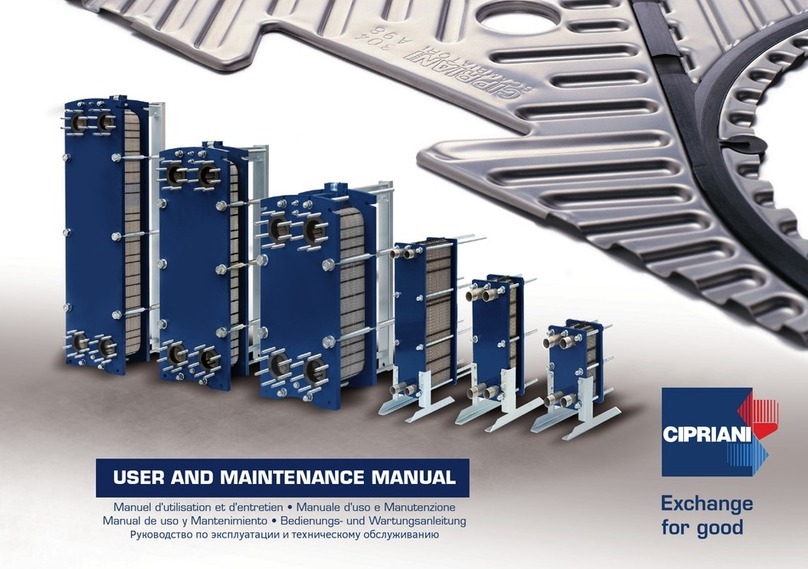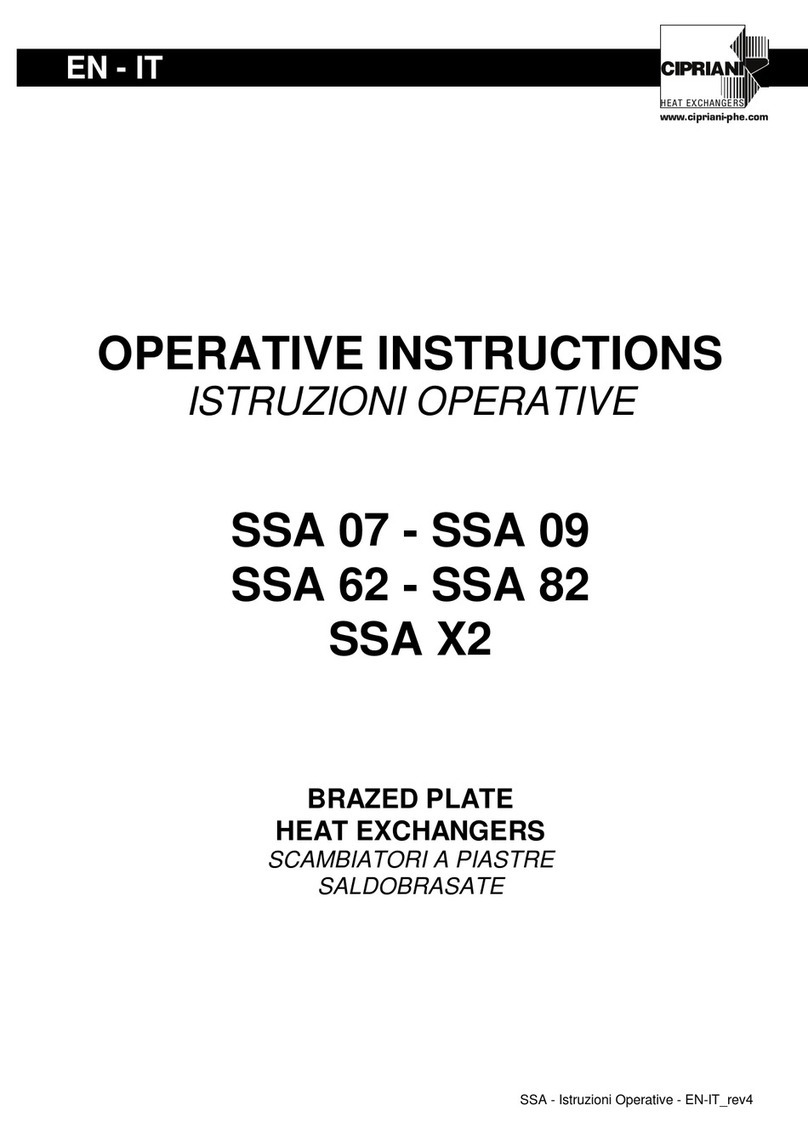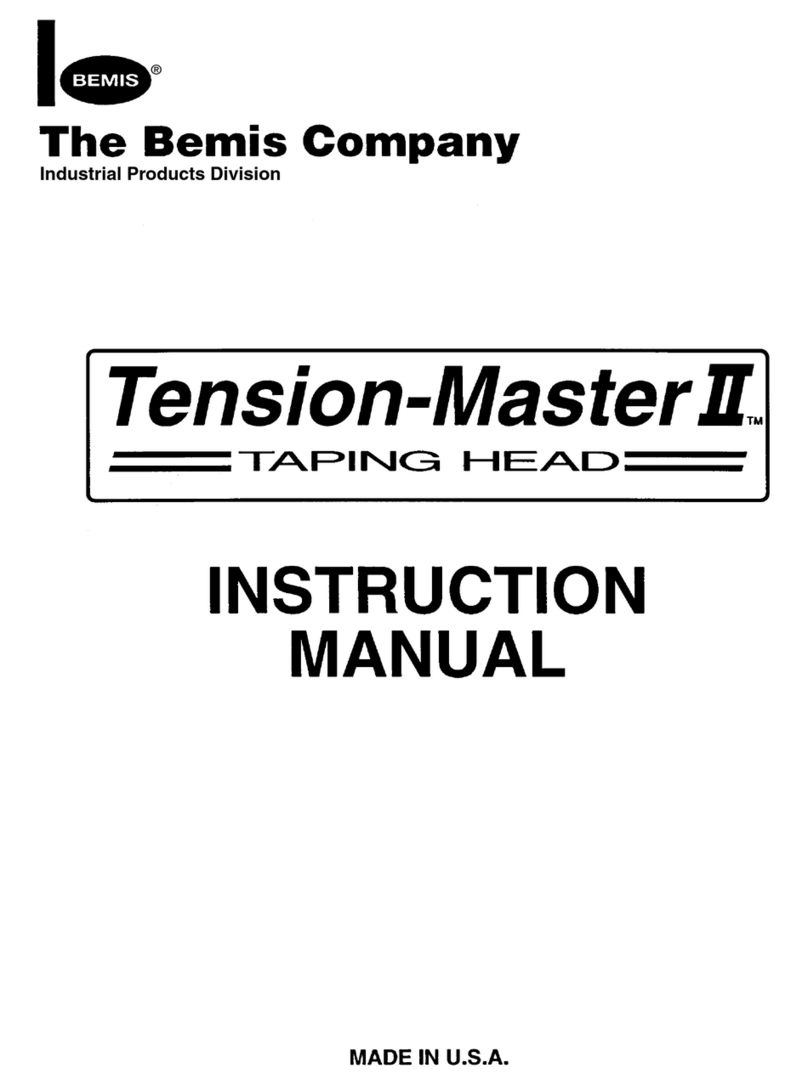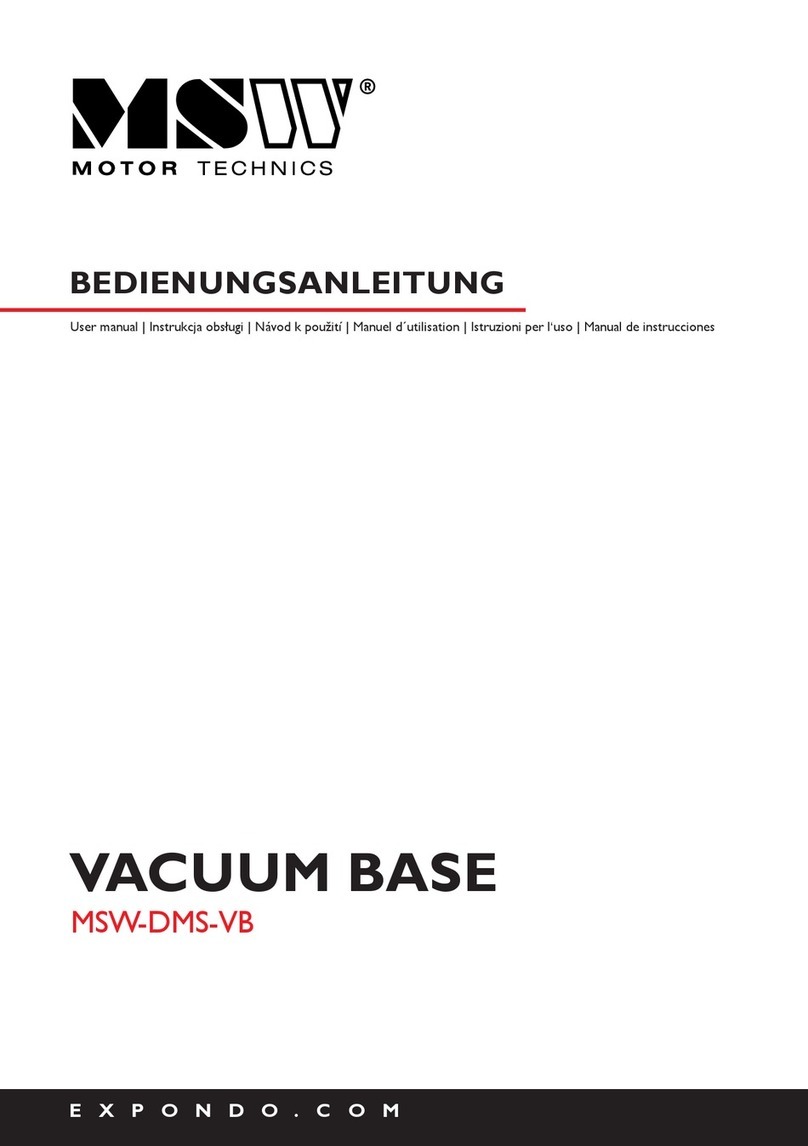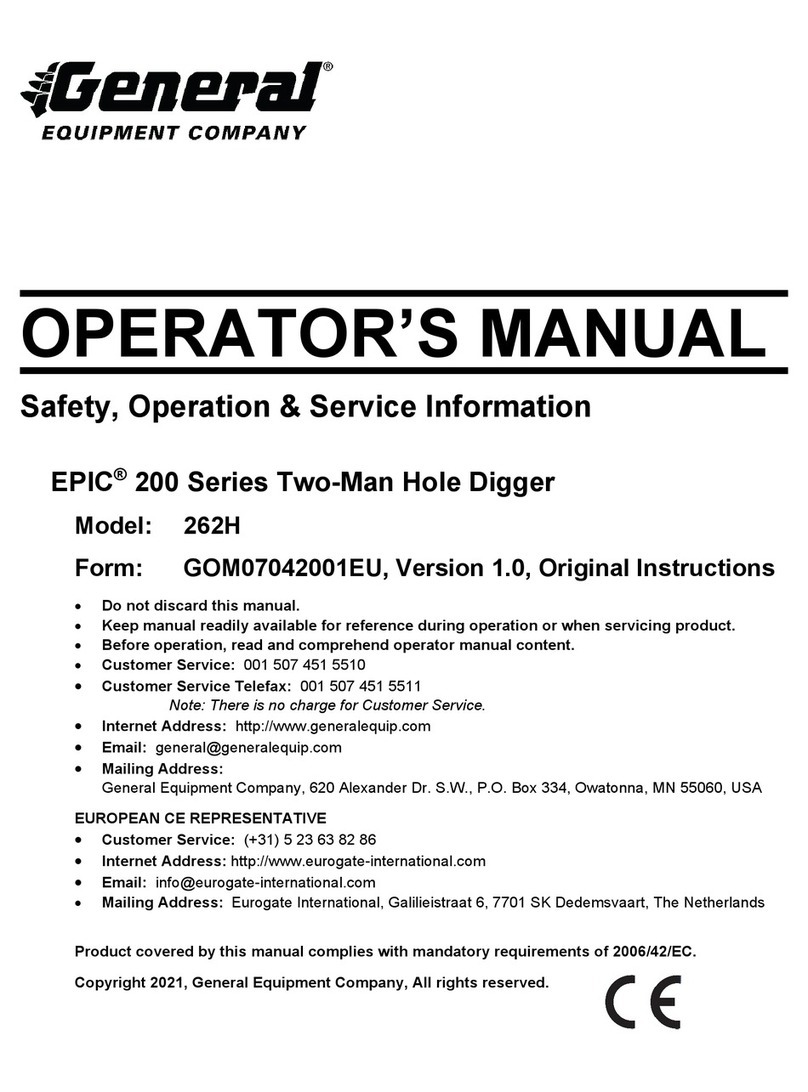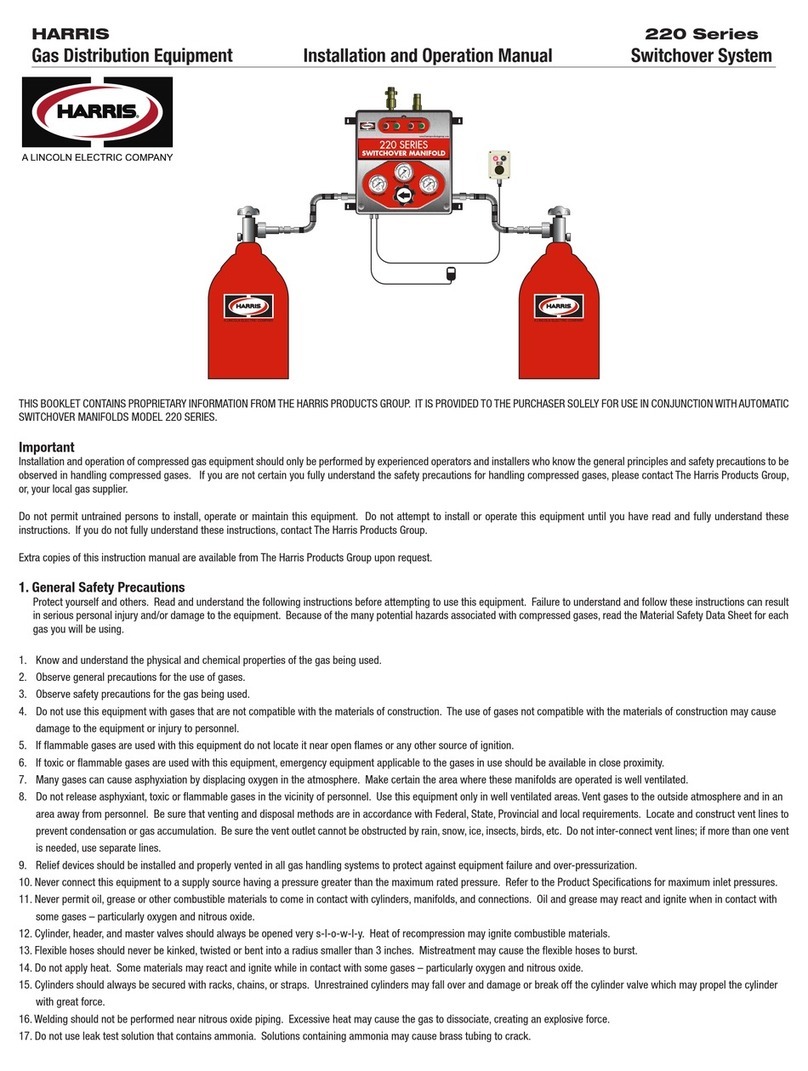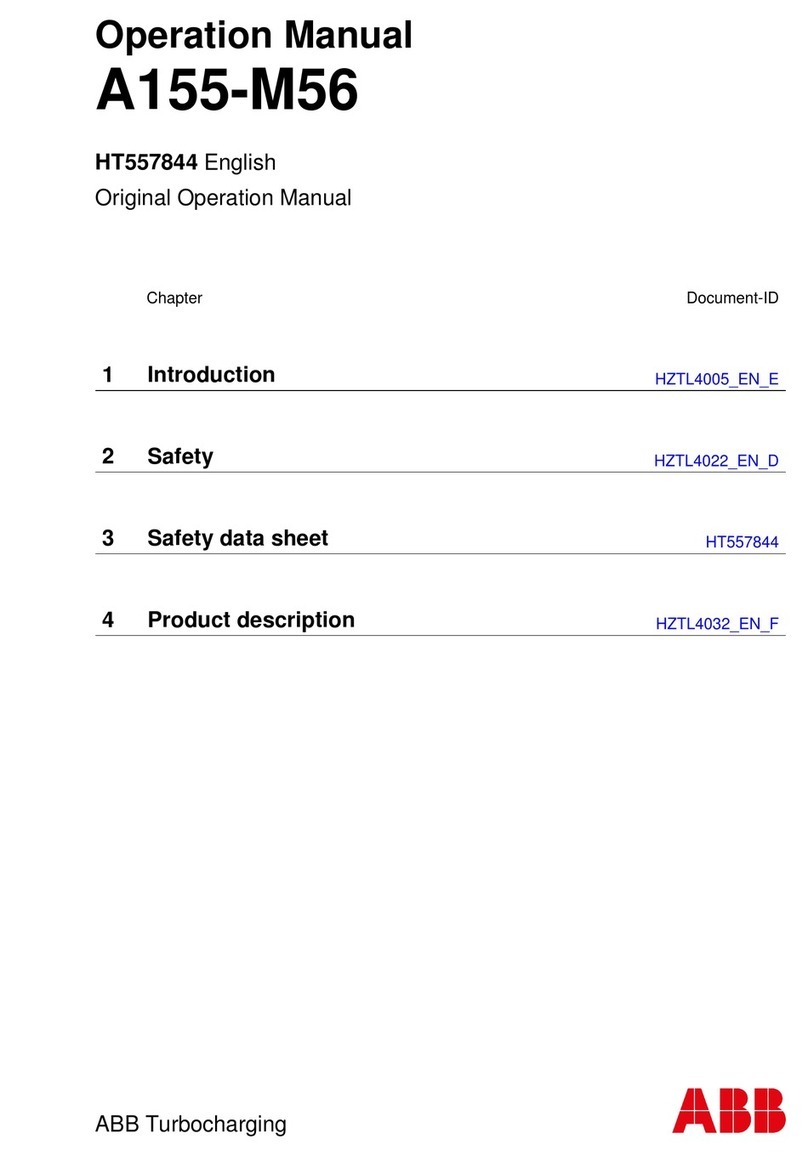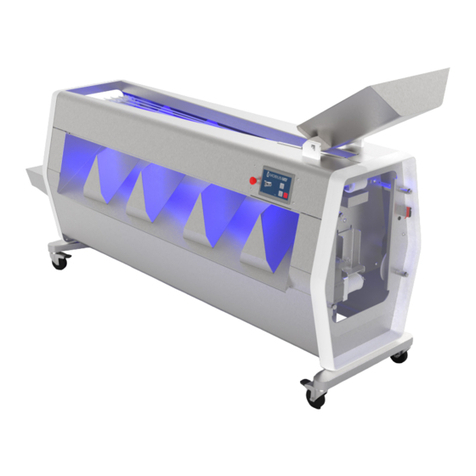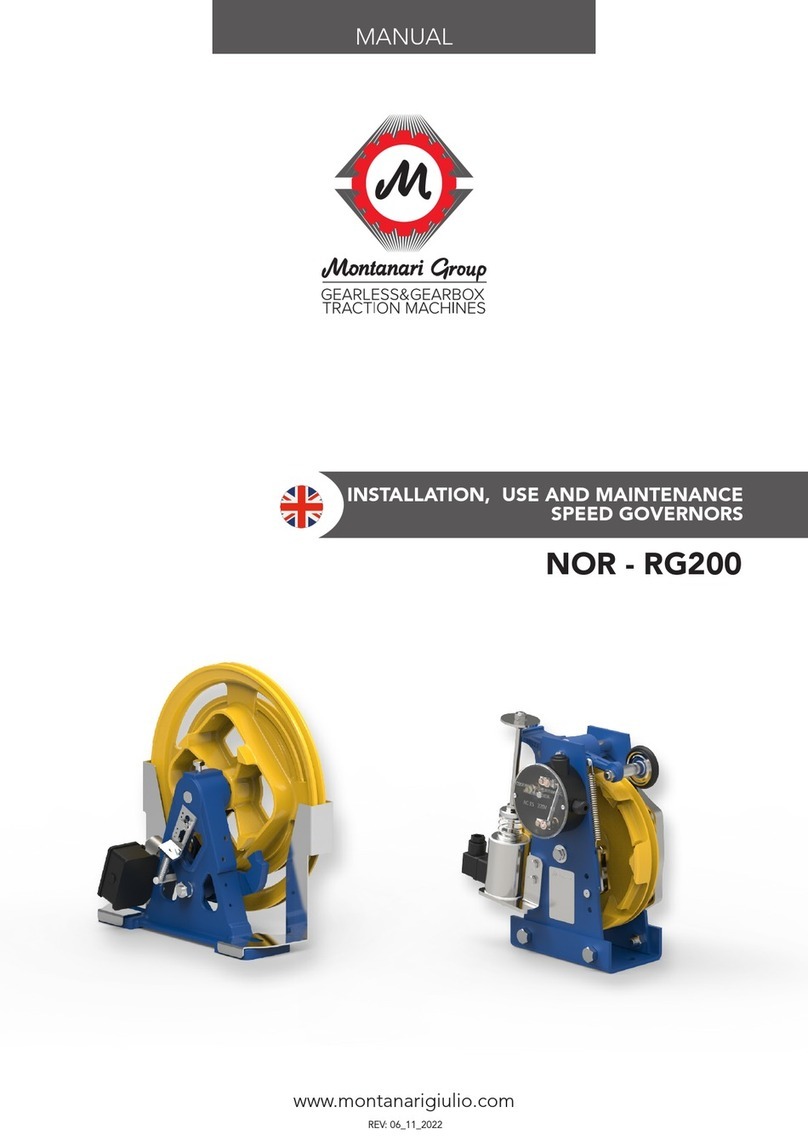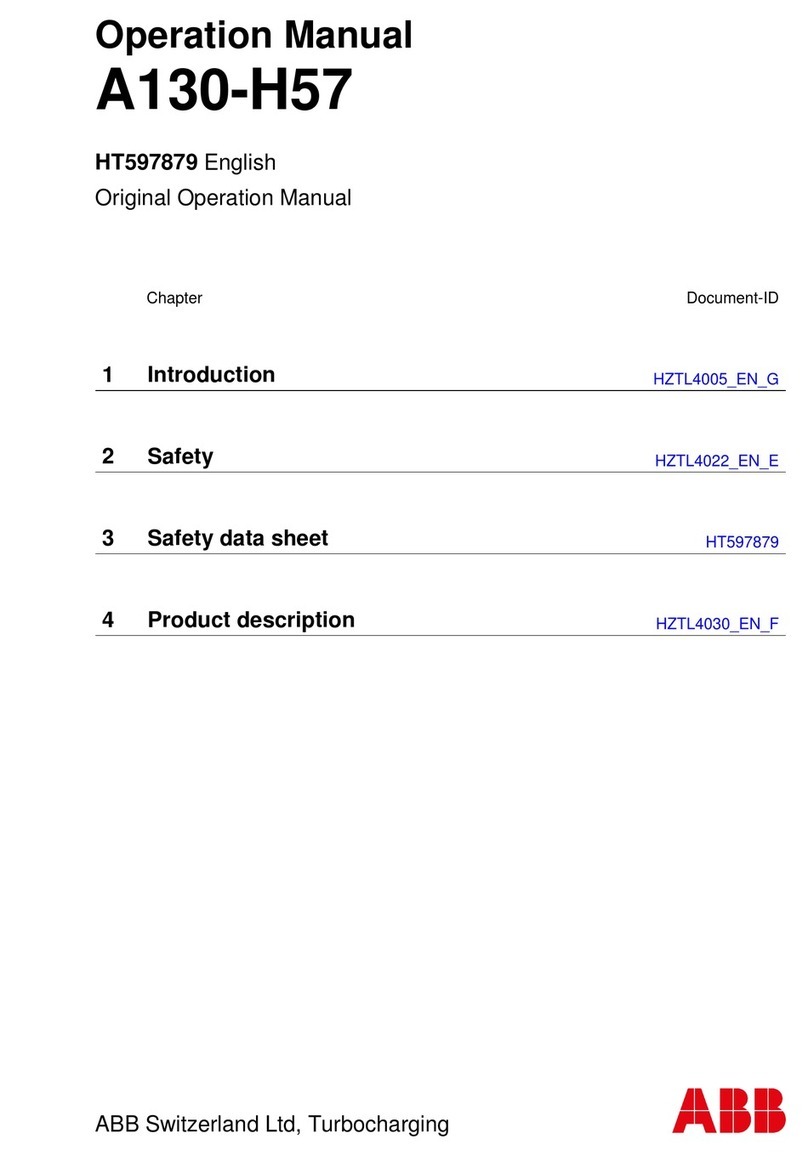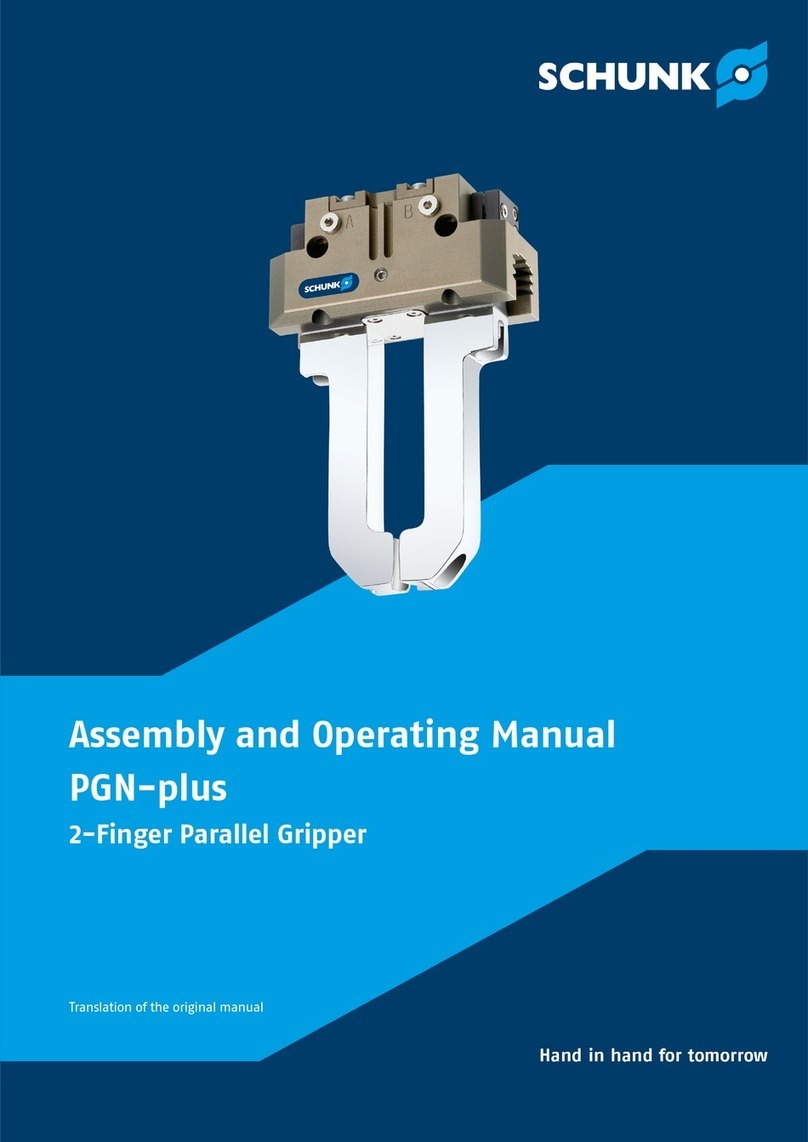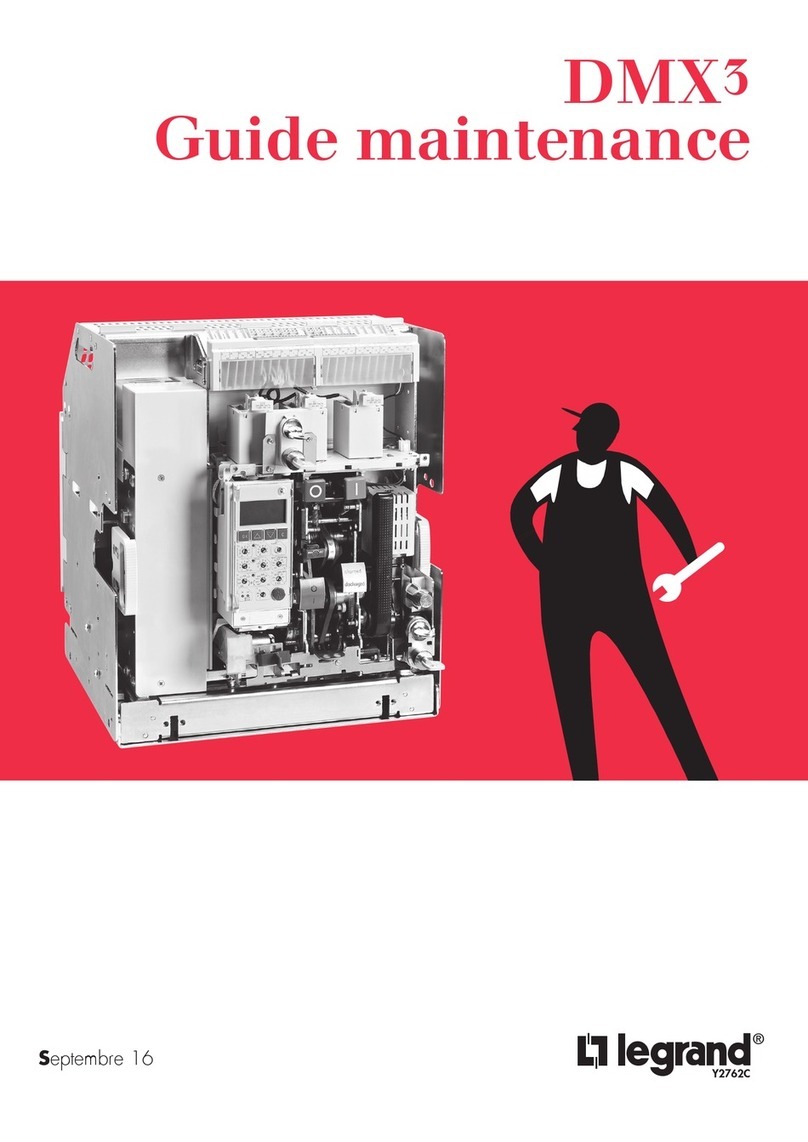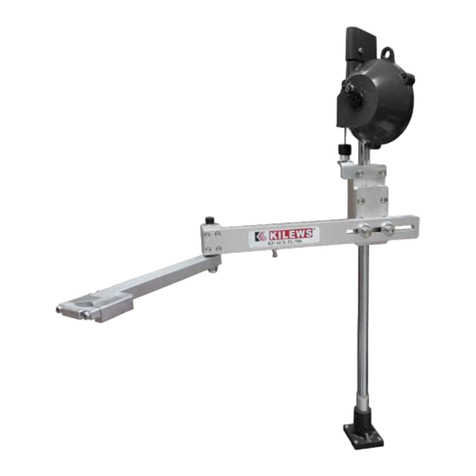CIPRIANI BRAZED PLATE HEAT EXCHANGERS User manual

220101 - OM_SSA-EN-IT
ENGLISH
ENGLISH / ITALIANO
BRAZED PLATE HEAT EXCHANGERS
MOUNTING AND OPERATION MANUAL
SCAMBIATORI DI CALORE A PIASTRE SALDOBRASATE
ISTRUZIONI PER L’INSTALLAZIONE,
USO E MANUTENZIONE
-

1
ENGLISH
Contents
Mounting and Operation Manual ...................................................................................... 2
1. General information .................................................................................................. 3
2. Safety instructions ..................................................................................................... 3
3. Installing and mounting............................................................................................. 4
4. Connections............................................................................................................... 5
5. Installation using solder (sweat), welding and threaded connections. ..................... 6
6. Initial operation ......................................................................................................... 7
7. Operation .................................................................................................................. 7
8. Protection against freezing........................................................................................ 8
9. Fouling, scaling, clogging ........................................................................................... 8
10. Cleaning ................................................................................................................ 9
11. Corrosion .............................................................................................................. 9
12. The operational conditions and nomenclature of our BPHE. ............................. 11
13. Connection scheme ............................................................................................ 12
14. The insulation mounting instructions ................................................................. 13
15. Warranty............................................................................................................. 13

ENGLISENGL
2
ENGLISH
BRAZED PLATE HEAT EXCHANGERS
MOUNTING AND OPERATION MANUAL
CAUTION!
Please carefully read the entire manual prior to
installation and operation. Otherwise, it may
cause injury or equipment damage.
Upon receipt of the BPHE delivery, all claims
about external damage or incomplete
consignments should be reported in writing to
the logistic company.
BPHE design can bears sharp edges. Always use
safety gloves and handle with caution.
Beware hot surfaces. During the operation
process the surfaces of the BPHE might reach
high temperatures.
(Caution! Hot surfaces) ->

3
ENGLISH
1. General information
Our brazed plate heat exchangers (further –BPHE or heat exchanger) are designed and
manufactured capable to withstand loads, created by temperature and pressure fluctuations.
Our BPHEs are available in a wide spectrum of sizes, can be used for different working
environments and pressures. The typical examples of working environments are synthetic
and mineral oils, water (excluding sea water), solutions of ethylene- and propyleneglycol,
refrigerating mediums (excluding natural mediums –ammonia and carbon dioxide, as well as
usage in the transcritical cycle).
The designations of the present manual correspond to the whole nomenclature of our
heat exchangers. It is necessary additionally to take in account the specifications of the order
of every single heat exchanger.
The mounting and operation of brazed plate heat exchangers should be performed by
expressly educated specialists, taking in account all state and international norms and
regulations on the matters of safety and accident protection.
Different types of plates are offered to allow using the BPHE for different purposes. The
choice of the heat exchanger and the type of plates is determined by the temperature
schedule and allowable pressure drop.
The Manufacturer’s information about the type of BPHE, model, date of manufacture,
serial number, manufacturer and technical parameters are specified on the label on BPHE.
Our heat exchangers are defined as equipment working under pressure in accordance
with the PED Directive of the European Parliament and of the Council.
2. Safety instructions
The heat exchangers are allowed to undergo works and repairs only in case the unit is
not under pressure and the temperature of its surface is below 40°C!
Using the heat exchanger by high temperature provide it with necessary heat insulation.
Be cautious close to the heat exchanger to avoid scorches!
In case the heat exchanger is operated in I category environments or with dangerous
liquids and gasses, comply with the obligatory terms of safety!
Do not drop the brazed plate heat exchanger from heights! During the mounting
process protect the heat exchanger from shocks!
Before installing the heat exchanger make sure the unit was not harmed during the
transportation and storage.

ENGLISENGL
4
ENGLISH
3. Installing and mounting
BPHE mounting position must ensure sufficient space
around the unit to be able to carry out maintenance works
and service. Installation position must allow the possibility
of venting and drainage.
Upon mounting the BPHE in the installation, the most
suitable orientation is vertical (up-right). All other positions
may cause loss in heat transfer efficiency or mechanical
problems.
For two-phase operation, BPHE must always be installed
in a vertical position (evaporator, condenser).
Never install a BPHE with the connectors facing down.
Use mounting brackets for BPHE fixation or support them
on their basis. It is not recommended to support the heat
exchangers just on the piping (e.g. on connectors or close
pipework).
Installing a heat exchanger, the maximum forces and
torques must not be exceeded.
During the mounting of the heat exchanger maximal loads on the fastening bolts must
not be exceeded.
Weld stud
Area of tension
mm2
Extension strength
Ft (N)
Torque
Mt (Nm)
M8x20
36.6
1060
16
M10x25
58
2250
32
M12x25
84.3
3270
56
The diameter
of connection
Displacement
Fs (kN)
Tension
Ft (kN)
Bending
moment
Mb (Nm)
Torque
Mt (Nm)
1/2" (DN15)
3.5
2.5
20
35
3/4" (DN20)
12
2.5
20
115
G 1” (DN25)
11.2
4
45
155
1 1/4" (DN32)
14.5
6.5
87.5
265
1 1/2" (DN40)
16.5
9.5
155
350
2” (DN50)
21.5
13.5
255
600
2 1/2” (DN65)
44.5
18
390
1000
Primary
channel
Secondary
channel

5
ENGLISH
4. Connections
In most standard applications for BPHE, the highest thermal efficiency can be achieved
through counter-current flow where the two fluids flow in opposite directions through the
BPHE.
Entrance of the primary BPHE channel is marked with a dot.
The circuit with the higher temperature and pressure should be connected to the
primary channel of the BPHE in case of the standard performance. The illustration provides
the example of connection of a one-way standard BPHE “water-water”. It is necessary to
connect the heat exchanger in counter-current flow to reach the maximal efficient operation
of the BPHE: the hot water supply from the heating system to the connector 1.1 (Q1), exit –
1.2 (Q4); the entrance of cold water to the connector 2.2 (Q3), exit –2.1 (Q2). It can be
explained with the fact that the secondary circuit of the BPHE has one more channel than the
primary circuit. In this case, the hotter heat carrier is placed between two cold channels. This
layout allows reducing the amount of heat losses.
The operation of the BPHE during the change of phase of the substance. Using the BPHE
in refrigeration units requires the channels of the cooling agent to be between the channels
of the water circuit. It is required to make the processes of condensation / evaporation more
effective and complete. In case the cooling agent circuit in mounted incorrectly the
temperature of evaporation becomes reduced, the possibility of unequal distribution of the
cooling agent in the BPHE appears, which can also lead to reduction of efficiency, the risk of
freezing of the heat exchanger appears, which as the final result might lead to the damage of
the BPHE.
Using the BPHE as a condenser, the gaseous cooling agent entrance is connected with
the upper connection of the primary circuit 1.1 (Q1), the exit of the liquid cooling agent –1.2
(Q4). The water / ethylene glycol circuit should be connected as a counter-current flow, the
entrance –to the bottom connector of the secondary circuit 2.2 (Q3) and exit –to the upper
connector of the secondary circuit –2.1 (Q2).
Using the BPHE as an evaporator, the entrance of the liquid cooling agent should be
connected to the bottom connector of the primary circuit 1.2 (Q4), the exit of the gaseous
cooling agent –to the upper connector of the primary circuit 1.1 (Q1).
The water / ethylene glycol circuit should be connected as a counter-current flow, the
entrance –to the upper connector of the secondary
circuit 2.1 (Q2) and exit –to the bottom connector of
the secondary circuit –2.2 (Q3). The regulating
expansion valve should be mounted as close as
possible to the entrance of the liquid cooling agent.
In case of use of heat exchangers for non-
standard or special schemes contact the
manufacturer or the representative of the company
for further information.
The illustration provides the numeration of the
connectors (the letters are used in accordance with
symbols used by the BPHEs calculation software).

ENGLISENGL
6
ENGLISH
Attention: Make sure that the BPHE is not exposed to severe vibration or pulsation. To
avoid that, vibration absorbers (e.g. mufflers) must be installed in pipework system, or
between the BPHE and other equipment must be vibration-absorbing material. The BPHE
lifetime will be significantly reduced, if there is insufficient system and flow control. The
following are some of the factors that have adverse effect on the life of the product.
The following impact should be avoided:
Excessive control valves;
Excessive pressure variations in the different channels of the system;
Poor quality control valves;
Improper controller settings.
Attention: Before connecting BPHE to new or renovated pipework systems, you have to
ensure that pipework is free from garbage and/or course particles which could clog the BPHE
fluid channels. To increase the safety of operation of the BPHE the installation of filters on
the entrance of the mediums is recommended, to prevent the getting into the channels of
small particles.
5. Installation using solder (sweat), welding and threaded
connections.
Soldered (sweat) connections
Clean and degrease the solder surfaces (both –on
the copper pipes and on the BPHE connectors).
Polish the surface to remove oxides. Solder the
surfaces. To prevent oxidation during soldering
process, fill the inside of the BPHE with nitrogen. Point
the flame towards the connectors.
Do not point the soldering equipment’s flame
against the BPHE, do not exceed soldering process
temperature higher than 650°C (1200°F). Soldering
material: with silver content not less than 45%. Use a
wet cloth (1) to prevent overheating of the BPHE. Make
sure the BPHE and tubes stay static during soldering
process.
Warning: excessive heat can lead to copper melting
while damaging the BPHE.
Welded connections
Use TIG (GTAW) welding.
Use a wet cloth (1) to prevent overheating of the
BPHE.

7
ENGLISH
To prevent oxidation during soldering process, fill the inside of the BPHE with nitrogen.
Threaded connections
Mount the BPHE first; add the pipes using threaded connectors.
The supply pipes of the BPHE should be fixed to avoid stress or tension of the thread
connections.
In case the buyer orders a junction or flange connection separately from the BPHE, we do
not feel responsible for bad quality braze/sweat of given connectors or possible accidents.
6. Initial operation
Before putting the BPHE into operation, it has to be checked whether the specified
maximum operating parameters provided by the manufacturers label are not going to be
exceeded.
Check any fluid connections for potential leaks.
The pumps that supply the BPHE have to be equipped with shut-off valves. Pumps
capable of generating a higher working pressure than the BPHE is designed for must be fitted
with safety valves. The system has to be air-free to avoid interference with BPHEs function.
To avoid pressure surges, pumps have to be turned on while the valves are closed.
It is necessary to check whether the pulsations and impulses are not transmitted to the
BPHE. The correctness of the mounting of the pipelines has to be checked to avoid
unnecessary loads on the connectors.
To avoid hydrodynamic shocks and the traces of air in the system, the cut-off and air
escape valves have to be opened during launch. The valves on the supply and return lines
must be opened slowly as much as possible.
The air left in the system and BPHE reduces the operation efficiency, as well as increases
the risk for corrosion.
7. Operation
The exceeding of maximally permissible temperatures and pressures, provided on the
label of the BPHE, is not allowed during operation.
The operation of the BPHE under strong drops of temperature and jumps of pressure
might lead to the damaging of the BPHE and is not tolerated. In case strong drops of
temperature, jumps of pressure and the hydraulic shock have occurred, it is necessary to
stop the operation of the BPHE, inspect visually the unit and in case of necessity perform the
hydraulic pressure test.
During operation avoid temperature drops bigger than 100°C between the primary and
the secondary channels.
It is prohibited to use aggressive mediums that can lead to corrosion of the materials
of the BPHE.

ENGLISENGL
8
ENGLISH
If the BPHE is installed between the control valve and the differential pressure regulator
it must be verified, if there is not generated negative pressure while closing both
flow/pressure adjusting devices that can cause blockages in the system.
Regularly check the efficiency of the control device functionality and control the obtained
values. It would allow determining on time the interference in the operation of the BPHE (the
changes of the hydraulic parameters of the system, the necessity to perfoem washing-out).
Make sure to avoid any working conditions during operation which may exceed the
systems design limiting parameters and operation instructions.
Before switching off of the BPHE make sure that all the pumps are switched off. To stop
the operation of the BPHE slowly close the supply valves (first should be terminated the side
with the highest pressure). After long downtime of the object it is required to fully drain and
clean the BPHE. It is made due to the danger of freezing, as well as in the BPHE are used
dangerous and hazardous liquids, because the not completing of the actions might lead to
biological pollution.
While terminating the operation of the BPHE, it is required to stop the primary channel
first and only afterwards - the second. Restarting the operation, the secondary circuit is
launched first and only afterwards - the second, to reduce the possibility of heat exchanger
overheating.
Operating the BPHE by temperatures below 0°C (32°F) or above +40°C (104°F), is
required to use corresponding insulation.
In case of non-standard use not described in the manual, contact the manufacturer or
the representatives of the company for further information.
8. Protection against freezing
Freezing can lead to a severe damage of the BPHE due to formation of ice. If operating
conditions approach the freezing point, antifreeze agents, such as solutions of glycol, must
be applied.
The freezing might lead to damage of the BPHE.
Using the BPHE in refrigeration units as an evaporator, thoroughly check the parameters
of the BPHE with corresponding calculations. Use only corresponding regulation devices.
Avoid using of a vacuum pipe.
Use corresponding insulation for the BPHE.
9. Fouling, scaling, clogging
The reason of clogging of the BPHE and the emerging of scale can be reasoned with
several factors, for example, the velocity of flow, temperature, the quality of water.
To prevent the emerging and precipitation of small particles in the BPHE (> 1mm) install a
corresponding filters on the inputs to the heat exchanger (100 m). On the contrary, the
clogging of the plate channels becomes possible, which can also lead to the reduction of

9
ENGLISH
efficiency, the increase of pressure losses or the freezing of the heat exchanger operated as
an evaporator.
The precipitation of small particles can be avoided by providing high turbulence of the
flow.
Factors, contributing to the emerging of scale and other deposits in hot water supply
systems:
The quality of water (see table 11.1)
The velocity of heated water. Excessive heating contributes to the emerging of
calcium deposits.
The overly small flow of warm water in particular systems reduces the turbulence
of the flow. It is a common reason for the reduction of the self-cleaning effect. In
this case the exuding calcium is precipitating on the plates. It is very topical for hot
water supply systems.
In regions, where the content of calcium in water is high and an excessive risk of
emerging of the deposits of small particles is topical, it is recommended to desalt
and to mitigate the water.
The high temperature of plates in hot water supply systems increases the
possibility of emerging of scale and the risk of the deposit of small particles. The
temperature of the walls of the BPHE should not exceed 60°C (140°F).
10. Cleaning
The cleaning of the BPHE should be regularly performed to avoid the emerging of any
deposits in the channels of the heat exchanger. The cleaning must be performed in counter-
current flow regimen, using special cleaning agents and weak acids. It is necessary to check
the chemicals and cleaning agents for the reactions with copper and stainless steel. After the
cleaning the BPHE has to be rinsed with clean water.
It is necessary to obtain full information on the substances from the manufacturers of
the cleaning agents, to verify whether the substances are capable to have an impact on the
materials of the BPHE. The cleaning has to be performed under the instructions of the safety
and accident prevention, and corresponding to the recommendations of the manufacturers
of the cleaning agent.
Before using the cleaner, check the stability of the materials to its aggressive action. The
noncompliance to these conditions might lead to the damage of the BPHE.
11. Corrosion
The brazed plate heat exchanger consists of brazed corrugated plates made of
stainless steel and copper braze. It is important to avoid factors contributing to corrosion of
steel and copper, as well as contributing to the washing out of copper during the
exploitation. The noncompliance to these conditions might lead to the damage of the BPHE.

ENGLISENGL
10
ENGLISH
The basic properties of water, causing the corrosion of metals are: electroconductivity,
the pH level, the hardness of water, the alkalinity, the concentration of chloride-, sulfate-ions
and unbound oxygen, the content of sulfuric acid salts. The high content of chlorides and
sulfates increases significantly the probability of corrosion.
The oxidizing substances (for example, chlorine) strengthen the polarization and
contribute to the anodic dissolution.
To avoid electrochemical corrosion:
1. Heat exchanger must be grounded. The electric potential between heat exchanger
and the ground must be equal to 0. Ground impedance must be R <4 Ω.
2. The emerging of the galvanic effect, which occurs due to use of different metals,
cannot be tolerated. The arrangements for the separation of galvanic pairs have to
be envisaged, for example, using bronze or stainless steel adapters and connectors.
3. Comply with the recommendations of the manufacturer on the allowed
concentrations of impurities in the water (see table 11.1).
The recommended values of properties and impurities of water for BPHE:
Table 11.1
Parameter
Concentration
[mg/l]
Parameter
Concentration
[mg/l]
Electroconductivity
10-500 µS cm-1
Aluminum (Al)
> 0.2 mg/l
pH
7.5 –9.0
Iron (Fe)
< 0.2 mg/l
Hardness
1.2
Manganese (Mn)
< 0.1 mg/l
(HCO3
¯)
70 –300
Ammonia (NH3)
< 2 mg/l
Sulfates (SO4
2-)
< 70
Nitrates (NO3)
< 100 mg/l
(HCO3
¯)/(SO4
2-)
> 1.0
Unbound carbon dioxide
(CO2)
< 5.0
Sulfites (SO3), unbound
chlorine (Cl2)
< 1.0
Nitrogen sulfide (H2S)
< 0.05
Chlorides (Cl¯), in
dependence of
temperature
0 ppm (>100°C)
< 100 ppm (80°C)
< 300 ppm (40°C)
Copper
2.0 mg/l

11
ENGLISH
12. The operational conditions and nomenclature of our BPHE
The internal volume of the BPHE can be determined after the formula:
Vmax=Vch x N,
where Vmax - interal volume of the heat exchanger
Vch - volume of the channel
N - amount of channels
Table 12.1
Model
Maximal
operation
pressure
(PS)
LB/NB
Maximal
operation
temperature
(TS)
Test pressure
(PT)
LB/NB
Volume of a
single channel
Maximal amount
of channels
Maximal
flow rate
bar
°C
bar
liters
pcs.
m3/h
238
16/31
+200
28.4/55
0,039
50
5,3
328
16/31
+200
28.4/55
0,055
50
5,3
464/468
16/31
+200
28.4/55
0,078
60
6,9
134/136/138
16/31
+200
28.4/55
0,082
140
13
534/536/538
16/31
+200
28.4/55
0,116
140
13
754/756/758
16/25
+135
28.4/40
0,279
200
39
Table 12.2
Model
A
B
C
D
E
L
NB
(LB)
Weight
(empty)
NB
(LB)
mm
mm
kg
238
90
226
43
182
22,1
11,1+2,35*N
(8,75+2,35*N)
0,965+0,062*N
(0,881+0,062*N)
328
90
323
43
279
22,1
11,1+2,35*N
(8,75+2,35*N)
1,293+0,089*N
(1,182+0,089*N)
464/468
94
463
43
415
22,1
14,95+2,35*N
(12,6+2,35*N)
1,811+0,128*N
(1,661+0,128*N)
134/136/138
123
380
64
320
27,1
14,83+2,29*N
(12.54+2,29*N)
2,338+0,13*N
(2.168+0.13*N)
534/536/ 538
123
531
64
471
27,1
14,83+2,29*N
(12,54+2,29*N)
3,024+0,186*N
(2,798+0,186*N)
754/756/758
264
547
174
456
27,1
15,9+2,35*N
(13,55+2,35*N)
8,505+0,389*N
(6,983+0,389*N)

ENGLISENGL
12
ENGLISH
13. Connection scheme

13
ENGLISH
14. The insulation mounting instructions
The mounting of heat insulation has to be performed after completing of the soldering
and welding works and when the equipment has cooled.
Before installation of the insulation package, make sure that the appropriate size is
chosen and it complies with the surface of the BPHE.
As the insulation used is sectional, its mounting can be performed on already installed
and functioning heat exchangers.
15. Warranty
The warranty considers defects of material and the product, which occurred during the
manufacturing process. The warranty is not covering defects and damage that were created
during the mounting and operation (including corrosion and freezing of the heat exchanger).
The basics of operational properties of our BPHE are the correct mounting, service and
operation conditions, which are described in the provided manual. We do not bear
responsibility for losses, occurred due to noncompliance to these conditions.
Attention:
The mounting and servicing of the BPHE has to be provided in compliance with the
present manual. In case this condition is not fulfilled we do not bear responsibility for the
operation of the BPHE.
For additional information contact the manufacturer or his representatives.

1
ITALIANO
Sommario
Istruzioni per l’installazione, Uso e Manutenzione ............................................................ 2
1. Informazioni generali................................................................................................. 3
2. Istruzioni di sicurezza................................................................................................. 3
3. Installazione e assemblaggio ..................................................................................... 4
4. Raccordi..................................................................................................................... 5
5. Installazione mediante brasatura, saldatura e raccordi filettati................................ 6
6. Avviamento iniziale ................................................................................................... 7
7. Funzionamento.......................................................................................................... 7
8. Protezione antigelo ................................................................................................... 8
9. Sporcamento, depositi, intasamenti.......................................................................... 8
10. Pulizia.................................................................................................................... 9
11. Corrosione ............................................................................................................ 9
12. Condizioni di esercizio e nomenclatura dello scambiatore................................. 11
13. Schema di collegamento..................................................................................... 12
14. Istruzioni di montaggio della coibentazione ....................................................... 13
15. Garanzia.............................................................................................................. 13

ITALIANO
2
ITALIANO
SCAMBIATORI DI CALORE A PIASTRE SALDOBRASATE
ISTRUZIONI PER L’INSTALLAZIONE,USO E MANUTENZIONE
ATTENZIONE!
Leggere attentamente l’intero manuale prima
dell’installazione e della messa in funzione onde
evitare lesioni o danni ai componenti.
Segnalare qualsiasi danno esterno o lotto
incompleto alla società di spedizioni al momento
della ricezione della consegna degli scambiatori.
Gli scambiatori puossono presentare bordi
affilati. Utilizzare sempre guanti di sicurezza e
manipolare con cautela.
Prestare attenzione alle superfici calde. Durante
il funzionamento le superfici dello scambiatore
potrebbero raggiungere temperature elevate.
(Attenzione! Superfici calde) ->

3
ITALIANO
1. Informazioni generali
I nostri scambiatori di calore a piastre saldobrasate (di seguito indicati come scambiatori
o scambiatori di calore) sono progettati e realizzati per sostenere carichi derivanti da
fluttuazioni di temperatura e pressione.
I nostri scambiatori sono disponibili in una vasta gamma di dimensioni e possono essere
utilizzati in diversi ambienti di lavoro e a pressioni differenti. Gli esempi tipici degli ambienti
di lavoro sono: acqua (esclusa l’acqua di mare), soluzioni di glicole etilenico o propilenico, oli
sintetici e minerali, mezzi refrigeranti (esclusi quelli naturali, ammoniaca e anidride
carbonica, come l’utilizzo nel ciclo transcritico).
Le designazioni indicate nel presente manuale corrispondono alla nomenclatura
completa dei nostri scambiatori di calore. È inoltre necessario considerare le specifiche
dell’ordine di ciascun scambiatore.
Il montaggio e la messa in funzione degli scambiatori di calore a piastre saldobrasate
devono essere eseguiti da tecnici esperti, sulla base delle norme e dei regolamenti nazionali
e internazionali in materia di sicurezza e protezione contro gli infortuni.
Sono disponibili diversi tipi di piastre per usi diversi dello scambiatore. La scelta dello
scambiatore di calore e del tipo di piastre da utilizzare è determinata dalla temperatura e
dalle perdite di carico consentiti.
Le informazioni sul tipo di scambiatore, modello, data di costruzione, numero di serie,
parametri tecnici e costruttore sono riportate sull’etichetta dello stesso.
I nostri scambiatori di calore sono definiti come recipienti in pressione, conformemente
alla Direttiva PED del Parlamento e del Consiglio europeo.
2. Istruzioni di sicurezza
Gli scambiatori di calore possono essere sottoposti a interventi di manutenzione e
riparazione solo quando l’unità non è sotto pressione e la temperatura superficiale è
inferiore a 40°C (104°F)!
In caso di utilizzo dello scambiatore di calore a temperatura elevata, dotare lo stesso di
idoneo isolamento termico. Mantenere una certa distanza dallo scambiatore di calore onde
evitare bruciature!
Rispettare i termini obbligatori di sicurezza in caso di utilizzo dello scambiatore di
calore in ambienti di categoria I o con liquidi e gas pericolosi.
Non far cadere lo scambiatore di calore a piastre saldobrasate dall’alto! Durante la
procedura di assemblaggio, proteggere lo scambiatore da eventuali urti!
Prima di procedere all’installazione, assicurarsi che l’unità non abbia subito danni
durante il trasporto e lo stoccaggio.

ITALIANO
4
ITALIANO
3. Installazione e assemblaggio
La posizione di installazione dello scambiatore deve
garantire uno spazio sufficiente intorno all’unità per
eseguire gli interventi di manutenzione e di servizio
necessari. La posizione di installazione deve garantire
altresì la possibilità di sfiato e drenaggio.
Si consiglia di installare lo scambiatore in posizione
verticale (a sinistra). Tutte le altre posizioni potrebbero
generare problemi meccanici o cali di efficienza durante il
trasferimento di calore.
Per le applicazioni che prevedono passaggio di fase
(evaporatore, condensatore), installare lo scambiatore
sempre in posizione verticale.
Non installare lo scambiatore con i raccordi rivolti verso
il basso. Utilizzare delle staffe di montaggio per fissare o
bloccare gli scambiatori sugli appositi basamenti. Si
sconsiglia di utilizzare le tubazioni (ad esempio raccordi o
tubazioni vicine) come unico sostegno per gli scambiatori.
Non superare le forze e le coppie massime previste
durante la fase di installazione.
Non superare i carichi massimi consentiti sui bulloni di fissaggio (opzionali) durante
l’assemblaggio dello scambiatore di calore.
Perno saldato
Area di tensione
mm2
Resistenza alla trazione
Ft (N)
Coppia
Mt (Nm)
M8x20
36,6
1060
16
M10x25
58
2250
32
M12x25
84,3
3270
56
Diametro del
raccordo
Spostamento
Fs (kN)
Tensione
Ft (kN)
Momento
flettente
Mb (Nm)
Coppia
Mt (Nm)
1/2" (DN15)
3,5
2,5
20
35
3/4" (DN20)
12
2,5
20
115
G 1” (DN25)
11,2
4
45
155
1 1/4" (DN32)
14,5
6,5
87,5
265
1 1/2" (DN40)
16,5
9,5
155
350
2” (DN50)
21,5
13,5
255
600
2 1/2” (DN65)
44,5
18
390
1000
Circuito
primario
Circuito
secondario

5
ITALIANO
4. Raccordi
Nella maggior parte delle applicazioni standard degli scambiatori, è possibile ottenere la
massima efficienza termica mediante flusso controcorrente, con i due fluidi che procedono in
direzioni opposte.
L’ingresso del circuito primario dello scambiatore è contraddistinto da un punto.
In caso di condizioni di utilizzo standard, collegare il circuito con la temperatura e la
pressione maggiori al circuito primario dello scambiatore. L’immagine riporta un esempio di
raccordo a uno scambiatore single-pass standard “acqua-acqua”. Per ottenere la massima
efficienza è necessario collegare lo scambiatore in flusso controcorrente: ingresso dell’acqua
calda dal sistema di riscaldamento raccordo 1.1 (Q1), uscita raccordo 1.2 (Q4), entrata
dell’acqua fredda raccordo 2.2 (Q3), uscita raccordo 2.1 (Q2). Quanto sopra può essere
spiegato considerando che il circuito secondario dello scambiatore dispone di un canale in
più rispetto a quello primario. In tal caso, il termovettore più caldo viene posizionato tra due
canali freddi. Questa disposizione consente di ridurre dispersioni.
Funzionamento dello scambiatore con cambiamento di fase di un fluido. Quando si
utilizza lo scambiatore in unità di refrigerazione, i canali del fluido refrigerante devono essere
posizionati tra i canali del circuito dell’acqua. E’ necessario rendere i processi di
condensazione/evaporazione più efficaci e completi. Qualora il circuito del fluido refrigerante
non sia installato correttamente, la temperatura di evaporazione diminuisce, generando il
rischio di distribuzione non uniforme del fluido refrigerante all’interno dello scambiatore, il
che potrebbe provocare un calo in termini di efficienza, oltre al rischio di congelamento e
conseguente danneggiamento dello scambiatore.
Qualora si utilizzi lo scambiatore come condensatore, collegare l’ingresso del fluido
refrigerante (gas) al raccordo superiore del circuito primario 1.1 (Q1), l’uscita del fluido
refrigerante (liquido) sarà quindi 1.2 (Q4). Collegare il circuito dell’acqua/glicole etilenico in
flusso controcorrente: l’ingresso al raccordo inferiore del circuito secondario 2.2 (Q3) e
l’uscita al raccordo superiore del circuito secondario 2.1 (Q2).
Se si utilizza lo scambiatore come un evaporatore, collegare l’ingresso del fluido
refrigerante (liquido) al raccordo inferiore del circuito
primario 1.2 (Q4) e l’uscita dell’agente refrigerante
(gas) al raccordo superiore del circuito primario 1.1
(Q1). Collegare il circuito dell’acqua/glicole etilenico in
flusso controcorrente: l’ingresso al raccordo superiore
del circuito secondario 2.1 (Q2) e l’uscita al raccordo
inferiore del circuito secondario 2.2 (Q3). Installare la
valvola di regolazione ad espansione il più vicino
possibile all’ingresso del fluido refrigerante liquido.
Contattare il costruttore o il rappresentante della
società per maggiori informazioni in caso di utilizzo
degli scambiatori di calore per operazioni non
standard o particolari. L’immagine riporta la
numerazione dei raccordi (le lettere sono conformi ai simboli utilizzati dal software di calcolo
degli scambiatori).

ITALIANO
6
ITALIANO
Attenzione: Assicurarsi che lo scambiatore non sia esposto a vibrazioni o impulsi forti. In
tal senso, installare degli smorzatori di vibrazioni (es. silenziatori) nel sistema delle tubazioni
o collocare del materiale smorzante tra lo scambiatore e le altre apparecchiature. Un sistema
inadeguato e un controllo del flusso insufficiente potrebbero ridurre significativamente la
durata di vita dello scambiatore. Di seguito si riportano alcuni dei fattori che potrebbero
compromettere la vita del prodotto.
Evitare quanto segue:
Valvole di controllo eccessive;
Variazioni di pressione eccessive nei vari canali del sistema;
Valvole di controllo di scarsa qualità;
Impostazioni del dispositivo di controllo non idonee.
Attenzione: Prima di collegare lo scambiatore a un sistema di tubazioni nuovo o
ristrutturato, verificare che le tubazioni non contengano residui e/o particelle in grado di
ostruire i canali dei fluidi dello stesso. Per migliorare la sicurezza di funzionamento dello
scambiatore, si consiglia di installare dei filtri all’ingresso dei fluidi, in modo da evitare
l’infiltrazione di piccole particelle all’interno dei canali.
5. Installazione mediante brasatura, saldatura e raccordi filettati
Raccordi brasati
Pulire e sgrassare le superfici di brasatura (sia sui
tubi in rame che sui connettori dello scambiatore).
Lucidare la superficie per rimuovere gli ossidi.
Brasare le superfici. Per evitare ossidazioni durante il
processo di saldatura, riempire la parte interna dello
scambiatore con dell’azoto. Rivolgere la fiamma verso i
connettori.
Non rivolgere la fiamma delle apparecchiature di
brasatura verso lo scambiatore e non superare 650°C
durante il processo di brasatura. Materiale di
brasatura: con livelli di argento non inferiori al 45%.
Usare un panno bagnato (1) per evitare il
surriscaldamento dello scambiatore. Assicurarsi che lo
scambiatore e i tubi siano ben fermi durante il processo
di brasatura.
Attenzione: un riscaldamento eccessivo potrebbe
comportare lo scioglimento del rame e il conseguente
danneggiamento dello scambiatore.
Raccordi saldati
Utilizzare saldature TIG (GTAW). Usare un panno
bagnato (1) per evitare il surriscaldamento dello scambiatore.
Table of contents
Languages:
Other CIPRIANI Industrial Equipment manuals
